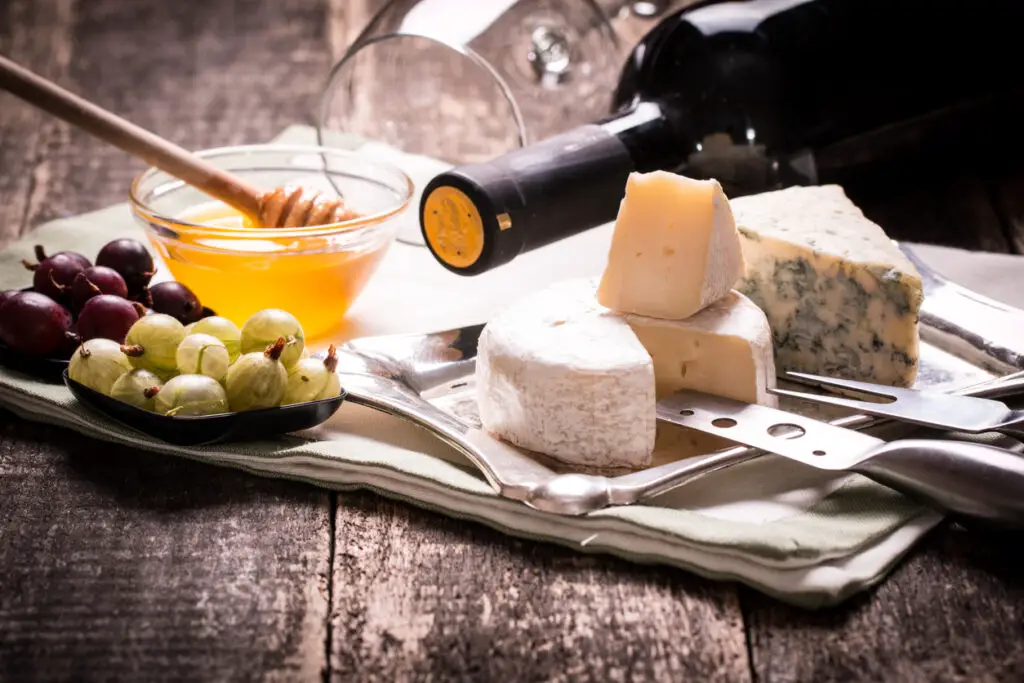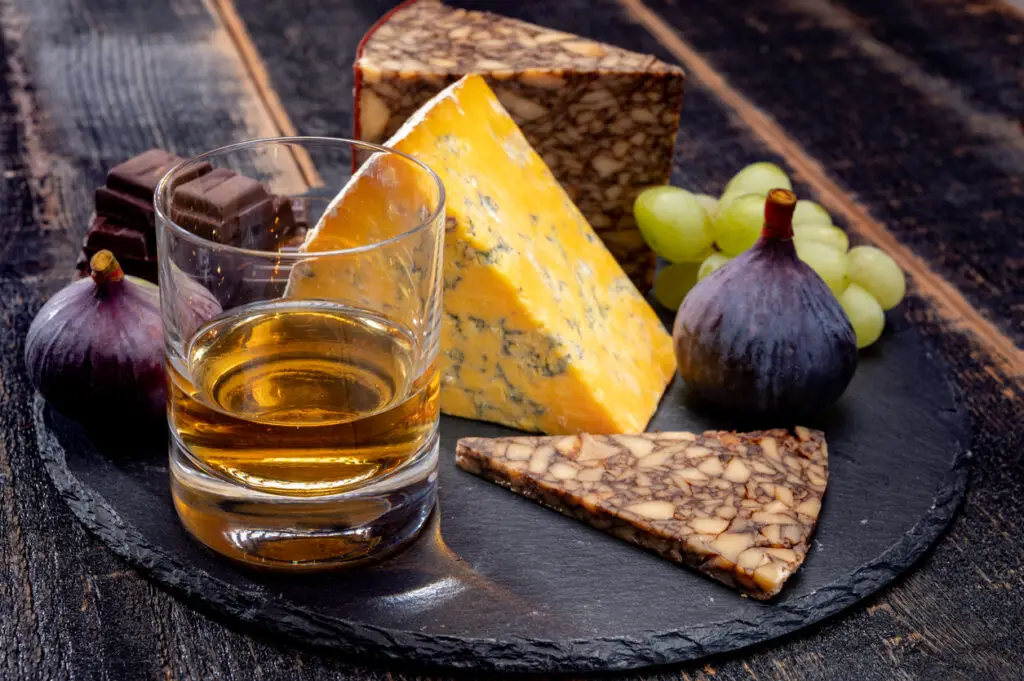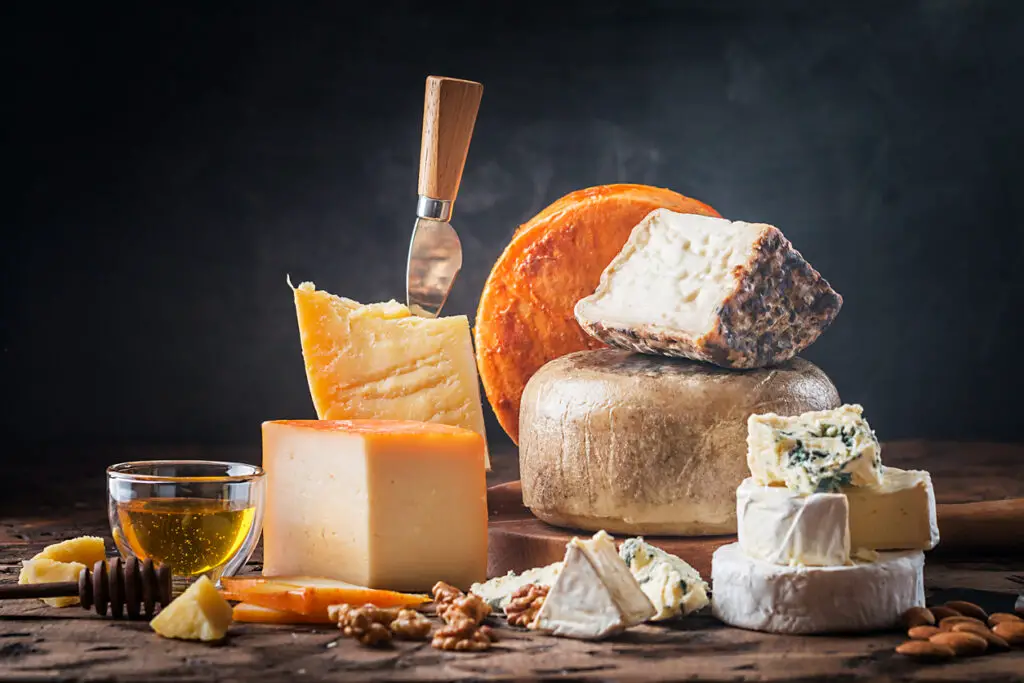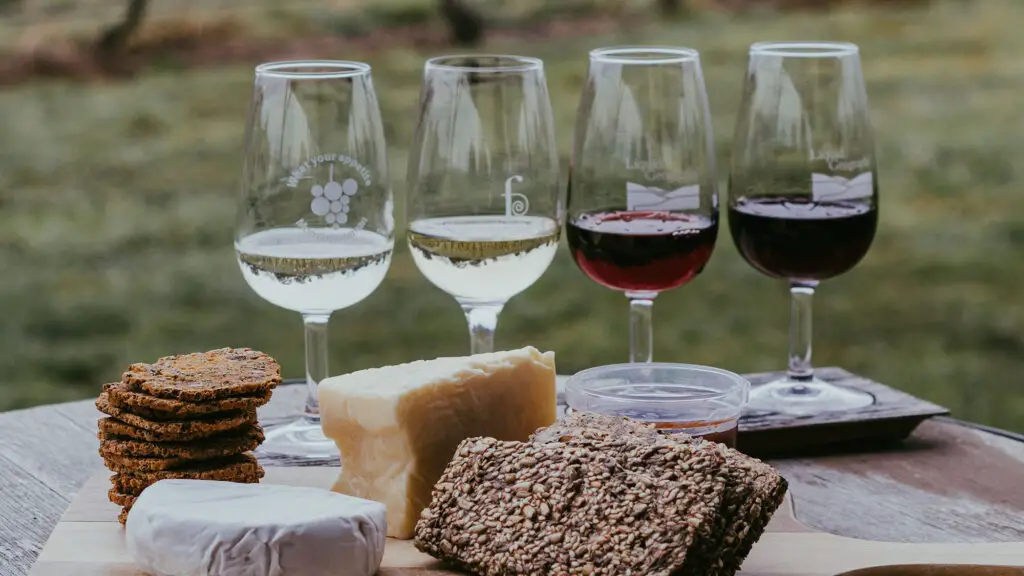Are you among those people who believe that cheese and red wine make the best pairing? Well, this is not entirely true. Not all types of cheeses go well with red wines. Still, if you enjoy reds, there are some tips to follow to create a perfect pairing. The key is to know your wine well to pair with cheese perfectly. As for today, let’s discuss what the best Merlot cheese pairing is.
Merlot pairs perfectly with gouda, gorgonzola, brie, and cheddar cheese. These creamy cheeses interact fabulously with Merlot’s mellow and deep flavor.
Let’s take a closer look to see what makes these types of cheese a great Merlot pairing.
History of Merlot
Before discussing Merlot cheese pairings, let’s firstly get introduced to the history of Merlot. According to various wine historians worldwide, the first mention of Merlot has its roots back to 1784 from Bordeaux high ranking public officials.
The name Merlot itself has a fascinating history behind it. It derives from the word merle or merlau, which were dialectical words describing blackbirds. Merlot grape gained popularity and quickly spread worldwide, referred to as “young blackbird” or “little blackbird” in the Bordeaux region of France.
Even though nowadays Merlot is considered one of the most popular grape varieties across the globe, in the beginning, it was used as a “secondary” grape. It means winemakers preferred blending Merlot with other grape varieties and not using it as a standalone varietal. As Merlot gained more and more popularity, winemakers started planting it around the world throughout time. Beginning around the late 19th century, Italian winemakers started cultivating Merlot. In the late 1980s, Merlot became one of the most widely planted grapes in the United States territory.
So, what exactly made Merlot so famous across the globe? Is it really that tasty?
Well, one of the best things about this variety is that it’s very “friendly,” as many wine lovers love to mention. Compared with other types, Merlot perfectly pairs with most of the dishes and can be great for small friends gathering and romantic date nights. Now let’s see what this famous wine tastes like.
Merlot Taste

Author Note: Merlot has a similar taste to Cabernet Sauvignon and is actually from the same grapes family ( a descendant of Cabernet Sauvignon). One of the key differences is that Merlot has a relatively thinner skin and tends to have fewer and softer tannins.
Unlike many other red wines, it maintains a less complicated body. Many people refer to Merlot as a “chameleon” wine because it varies immensely in taste depending on where the grape was grown. However, the familiar notes you will notice include ripe blue, black, and red fruit. These notes are backed by undertones of vanilla, earthier flavors, and cocoa.
Merlot can grow tremendously both in hot and cooler climates. If you taste Merlot from regions with warmer temperatures, you will notice how fruity with refined tannins it tastes. Classic examples of excellent Merlot from warmer regions include Napa Valley, Australia, or Argentina. A bottle of Merlot from those regions would have sweeter tannins, filled with blackberries, blueberries, plum, raspberry, and other fruity notes.
On the other hand, Merlot from cooler regions may have a contrasting taste. It will be more structured and filled with earthy flavors. If you try a glass of Merlot from cooler areas while blindfolded, you would easily mix it up with Cabernet Sauvignon.
One of the examples of cool climate Merlot is Right Bank Bordeaux, including Saint-Emilion or Pomerol. You will notice that Merlot from those regions has a ruby-garnet color, is relatively ripe or slightly tart fruit. While this wine from warmer regions may vary from medium to full-bodied, Merlot from cooler regions usually tends to be medium-bodied.
Now that we know the primary taste notes and flavors of Merlot let’s see which food pairings go best with it.
Merlot Food Pairing
Wine lovers like to refer to Merlot as their “flexible friend.”Because most Merlot bottles are medium-bodied, they tend to pair great with rich sauced dishes, such as steak (or even fish) with a sauce or casseroles. If you prefer full-bodied Merlot, consider pairing it with the dishes you would make with Cabernet Sauvignon. A great match would be roast beef or roast lamb.
On the other hand, when it comes to food pairing, the lightest bottles of Merlot are more flexible. Pizza or other toasted dishes, including quesadillas or panini, can be a great match to your light-bodied glass of Merlot. You may also think of cooking pasta with tomato-based sauces cooked with bacon or mushrooms, creating an ideal combination.
Like different wine and food pairings, Merlot can vary in taste, thus not having an ultimate perfect pairing with it. The critical thing is to know the tannins of your wine, try to choose your food to enhance the flavors of the delicious glass of Merlot.
Merlot Cheese Pairing
As we have already discussed, when it comes to food pairing, Merlot is a versatile wine. It is softer and less tannic compared to Cabernet Sauvignon and goes better with various types of cheese. Let’s discuss some of the best Merlot cheese pairing options.
Gouda

Merlot pairs perfectly with gouda. They are somewhat similar because Merlot is a versatile wine and gouda is a flexible cheese. Additionally, both have the same acid levels, making the pairing pleasant to anyone’s taste.
Brie
One of the world’s best and most popular cheeses, Brie can be slightly chalky and mild or relatively strong, so you need to know your wine first to pair it well. Try fruity, but not too tannic Merlot with a more mature Brie.
Cheddar
Author Note: As with many other pairings, the ideal wine and cheddar pairing depends on how mature it is. A mild to medium block cheddar is a lot easier to match than an aged one. Not only is Cheddar a great Merlot cheese pairing, but it also goes great with Cabernet Sauvignon.
It would help if you watched the tannins, though. A bottle of two or three years of age will match better with Cheddar than a younger one.
Gorgonzola
Soft and creamy gorgonzola cheese is another excellent pairing to soft red wines such as Merlot. Any international chefs use gorgonzola as a perfect addition to provide a different taste to delicious food. Like Merlot, this type of cheese is versatile too and can be paired well with sparkling wine.
Rules to Follow When Pairing Wine and Cheese
Although wine and cheese pairing may sound like a straightforward thing to do, there are many details you need to follow to create a perfect combination. When you want to pair wine and cheese, you should think of individual elements that make it exciting.
After this, try to find the most suitable wine and cheese bottle to complement or contrast those elements. Sound confusing? Let’s put it in simpler terms. In general, winemakers like to point out four essential tips to follow for having the best wine and cheese pairing experience.
The Intensity of a Wine
First of all, consider the intensity of your wine. This means that lighter wines like Sauvignon Blanc will pair perfectly with lighter, unaged cheese, including Brie or Ricotta. On the other hand, full-bodied and robust wines like Rioja makes an ideal pairing with something more complex like aged Gouda or Manchego.
Salty Cheese with Sweeter Wine
The second rule, while pairing wine and cheese, is to match salty cheese with sweeter wines. This will create a contrasting taste, which enhances hidden notes of your wine. For example, try pairing salty Parmesan or Pecorino Romano with a glass of bubbly like Prosecco or Champagne.
Many look at this pairing skeptically, but winemakers love the combination! Champagne or Prosecco’s acidity causes the mouth to salivate, compensating for the cheese’s saltiness (Parmesan or Pecorino Romano, whichever you choose).
Contrasting taste: Creamy and Sparkling Textures

The third rule to the ultimate perfect wine and cheese pairing is contrasting sparkling with a creamy texture. Have you ever thought that creamy cheese like Brie may go great with sparkling wine or Champagne?
Author Note: It may sound strange at first, but a sparkling wine like Champagne, which has crisp acidity, helps to cut through Brie’s creaminess, providing textural contrast. So, as soon as you try this pairing, you will immediately fall in love!
Regional Uniqueness
As we have previously discussed in the context of Merlot, this grape variety differs in taste based on where it was grown. Similarly, winemakers like to point out the importance of pairing the wine with cheese from the same region. Both cheese and wine are so closely connected; they can reflect the terroir of land as soon as you taste them together.
Frequently Asked Questions
Is Merlot good with charcuterie?
Absolutely. Merlot is an excellent choice for a charcuterie board. Merlot’s medium body and soft tannin levels make it versatile and able to pair well with a large variety of cheeses. The balanced acidity of Merlot cuts through the richness of many cheeses, making it an effective, but not overpowering, palate cleanser.
How is Merlot best served?
Merlot is generally best served slightly cooler than room temperature. Various types of Merlot benefit from being decanted. For older Merlot, a soft decanting method is ideal to remove aging sediment. Younger Merlot should be decanted for 30 minutes to an hour to soften tannins and release the aromas. A wide-bowled wine glass will allow the Merlot to breathe.
Should you let Merlot breathe?
If you can, you should try to let Merlot breathe. This process will soften the wine’s tannin levels and enhance its flavor and aromas, leading to a better taste experience overall. That being said, it isn’t mandatory.
Wrapping Up
To sum up, wine and cheese pairing may sound too easy at first, but in fact, it is a lot harder than it looks. Although some may think white wine pairs best with cheese, if you pair it well, you may enjoy a glass of red with cheese too! In general, one of the essential rules in wine and cheese pairing is to match them in terms of intensity.
As Merlot is relatively lighter-bodied for a glass of red wine, it is easier to develop a perfect merlot cheese pairing option. As we have already discussed, you can choose between gorgonzola, Brie, gouda, or parmesan as a great pairing to Merlot wine.
Make sure that the wine you choose follows all the rules we have mentioned above. You can also improvise choosing contrasting tastes and find a perfect combination by yourself! We hope you enjoyed this article on Merlot cheese pairing.
To living a full-bodied life,
Wesley

